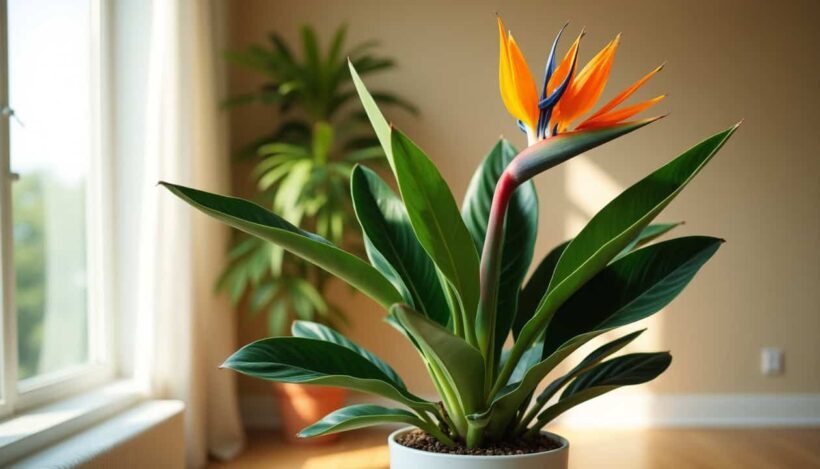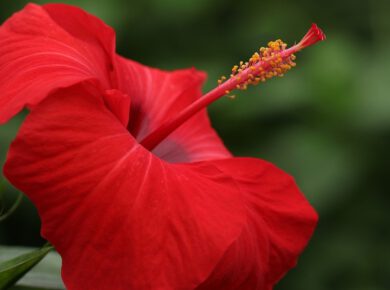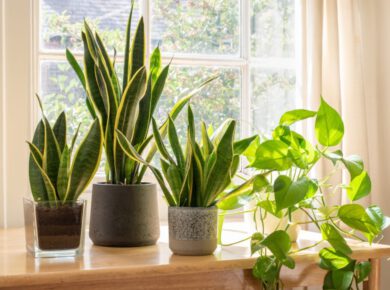Table of Contents Show
Nature’s most impressive houseplants include the bird of paradise plant that reaches heights of up to 30 feet tall under optimal conditions. This magnificent plant showcases stunning orange and blue blooms resembling exotic birds in flight. Each year it produces up to 36 flower spikes, and cut blooms last two weeks.
The banana plant’s relative might look dramatic, but growing it is easier than many other tropical species. Your bird of paradise plant runs on temperatures between 65-80°F and adapts well to different environments. My experience as a gardener confirms that both beginners and seasoned plant enthusiasts can succeed with this versatile plant.
This detailed piece covers everything you need to grow and care for these magnificent plants. You’ll learn about variety selection, optimal growing conditions, and solutions to common care challenges.
Understanding Bird of Paradise Plant Varieties
The bird of paradise belongs to the Strelitzia genus, which has five distinct species. Understanding these varieties will help you choose the perfect plant for your space.
Common Types and Their Characteristics
The Strelitzia reginae grows 5-6 feet tall and produces those iconic orange and blue flowers that bloom year-round. The Giant Bird of Paradise (Strelitzia Nicolai) is quite impressive – it towers up to 20 feet with massive leaves that span 5-10 feet in length. The Strelitzia alba shows off white flowers up to 12 inches long and reaches heights of 12-15 feet.
The Narrow-Leaved Bird of Paradise (Strelitzia juncea) catches everyone’s eye with its reed-like foliage and grows 4-6 feet tall. The Mountain Strelitzia (Strelitzia caudata) displays white flowers with purple tinges and grows to 6 feet in height.
Choosing the Right Variety for Your Space
Two specific varieties work great indoors. The Strelitzia reginae makes an excellent houseplant because of its manageable size. Space-conscious gardeners will love the Strelitzia juncea with its slender, cylindrical leaves.
White Bird of Paradise vs. Orange Bird of Paradise
The differences between these prominent varieties are most important. The White Bird of Paradise (Strelitzia nicolai) shows off larger leaves and shorter, thicker stems. The Orange Bird of Paradise (Strelitzia reginae) keeps its leaves smaller, usually no longer than 18 inches.
| Feature | White (Nicolai) | Orange (Reginae) |
|---|---|---|
| Height | Up to 20 feet | 5-6 feet |
| Flower Color | White with blue-gray | Orange and blue |
| Leaf Size | Large, banana-like | Medium, paddle-shaped |
| Indoor Suitability | Challenging | Excellent |
The White Bird of Paradise needs lots of space and rarely blooms indoors. The Orange variety adapts well to containers and blooms more often, making it a better choice for indoor growing.
Creating the Perfect Indoor Environment
Growing a bird of paradise plant indoors successfully depends on creating the right environment. My experience shows that getting three elements right makes all the difference when you nurture these tropical beauties.
Light Requirements and Placement
Bright, indirect light serves as the foundation for a successful bird of paradise care. These plants do best near south or west-facing windows. They need at least four hours of sunlight daily. Here’s my window placement guide to help you choose the perfect spot:
| Window Direction | Light Quality | Best For |
|---|---|---|
| South/West | Bright indirect/direct | Mature plants |
| East | Morning sun | Smaller specimens |
| North | Insufficient | Not recommended |
The winter months can be tricky. You might need to add grow lights when natural light drops to help maintain healthy growth.
Temperature and Humidity Control
These tropical beauties thrive in specific temperature ranges. The ideal daytime temperature falls between 65-80°F, and nighttime temperatures should stay above 50-54°F. Your plant will grow steadily if you keep temperatures consistent.
Humidity plays a vital role too. Bird of paradise plants thrive in humidity levels between 50-70%. I’ve managed to keep proper humidity through several methods:
- Using a humidifier near the plant
- Placing the pot on a pebble tray with water
- Regular misting (especially during dry seasons)
Space Planning for Different Growth Stages
Space needs change by a lot as these plants mature. A bird of paradise that stands 3-4 feet tall needs a 10-inch pot, while a 5-6 foot plant needs a 14-inch container. You should leave 2-3 feet of space around and above the plant so it can develop properly.
The plant’s growth stage determines its container needs. Bird of Paradise plants blooms better when slightly root-bound. You should report only when the plant becomes top-heavy or unsteady. Larger floor plants need repotting every 18-24 months, though this can stretch to 28 months if your plant shows healthy growth.
You May Also Read: DIY Guide to Growing and Taking Care of a Money Plant
Note that your bird of paradise should stay away from air vents and drafts. This smart placement, along with proper light exposure and humidity control, creates the perfect indoor environment for your plant to thrive.
Essential Bird of Paradise Plant Care Tips
Bird of Paradise plants need three main things to grow well: water, fertilizer, and pruning. These beautiful plants can thrive inside your home for years with the right care.
Watering Schedule and Techniques
The right amount of water is the life-blood of a healthy bird of paradise. You should water every 1-2 weeks and let the top 2-3 inches of soil dry between waterings. Light exposure and seasons will help you decide how often to water. These plants grow better with filtered water or water that sits overnight.
The plant needs less water from October to February. A soil probe is a great way to get moisture readings and helps aerate wet soil. Watch your plant’s leaves carefully – yellow colors, drooping, or splitting can mean too much water.
Fertilization and Soil Requirements
These plants need regular food during growing season. Use a balanced water-soluble fertilizer (1:1:1) twice a month in spring and summer. Plants growing outside do well with granular landscape fertilizers every three months.
Here’s a seasonal fertilization guide:
| Season | Frequency | Type |
|---|---|---|
| Spring/Summer | Bi-weekly | Water-soluble |
| Fall | Monthly | Organic |
| Winter | Minimal/None | – |
Soil quality is a vital part of plant health. Mix well-draining potting soil with peat, perlite, or sand. Outdoor plants benefit from 2-3 inches of organic mulch that helps keep moisture levels steady.
Pruning and Maintenance Guidelines
Your plant needs regular pruning to look good and stay healthy. Clean, sharp pruning shears help you remove damaged or yellow leaves at their base. Clean your tools with isopropyl alcohol between cuts so diseases don’t spread.
Plan big pruning jobs for early spring. Remember the one-third rule – don’t cut more than a third of what you can prune at once. Cut off dead flowers right away to help new ones grow and give the plant more energy.
You May Also Read: DIY Flower Bouquet: How to make a flower bouquet
Big plants might need a new pot every 18-24 months, though they like being a bit crowded. Pick a pot 2-4 inches wider when you repot to give the roots space to grow.
Managing Growth and Development
Strong roots are the foundations of a healthy bird of paradise plant. You’ll have better success with these majestic plants if you know how to manage their growth and development.
Supporting Healthy Root Systems
Healthy roots should feel firm and show a vibrant white color. Check your roots often for overcrowding instead of waiting until they’re severely bound. A strong root system will keep your plant secure and absorb nutrients quickly.
| Root Health Indicators | Action Required |
|---|---|
| White, firm roots | Maintain current care |
| Dark, mushy texture | Improve drainage |
| Protruding from holes | Think about repotting |
| Foul odor | Address root rot |
Your plant’s roots need well-draining soil that lets air flow freely. A mix of peat moss, perlite, and sand will create the best conditions for root development. After repotting, make sure the soil settles nicely around the roots so there aren’t any air pockets.
Encouraging Blooming Indoors
Bird of paradise plants usually take 4-5 years to reach blooming maturity. There are several factors that affect flowering success. Your plant needs at least four to six hours of full sun each day to produce blooms.
These plants bloom better when they’re slightly pot-bound. Moving them to bigger pots too often can delay blooming by up to two years. Just add fresh potting soil on top during spring instead of completely repotting.
Size Control and Shaping Methods
Spring or early summer works best for major pruning of your bird of paradise. Here are some proven ways to control size:
- Remove outer and top branches to manage spread
- Cut back stems to control height
- Keep the structure open so light gets through
- Trim away dead or diseased foliage
Don’t remove more than one-third of the plant material in a single season. Use clean, sharp tools to make precise cuts while pruning. Giant varieties can be cut back to ground level at the main trunk, which will encourage new shoots from the base.
You May Also Read: What Does the Lily Flower Represent
Root pruning is another quick way to control size. This helps develop new feeder roots and boosts nutrient absorption. Make sure you use sterilized tools and apply root hormone to the cuts when root pruning.
Troubleshooting Common Problems
Bird of paradise plants can face challenges that need quick attention and care, even when you manage to keep them healthy. Learning about common problems helps keep your plant healthy and stops serious issues before they start.
Identifying and Treating Plant Issues
Leaf problems often signal why things go wrong. Brown edges on leaves show up because of dry air and not enough water. Brown spots on the blade might mean too much water or temperature shock. Yellow leaves usually point to root rot from lack of nutrients.
| Problem | Cause | Solution |
|---|---|---|
| Brown leaf edges | Dry air/underwatering | Increase humidity/adjust watering |
| Yellow leaves | Root rot/nutrient issues | Check drainage/adjust fertilization |
| Drooping leaves | Low light/overwatering | Relocate plant/reduce watering |
| Split leaves | Low humidity | Increase moisture levels |
Root rot is a serious concern that comes from overwatering or poor soil drainage. When you smell rot in the soil, check the root ball and remove any black, moldy parts.
Preventing Pest Infestations
Spider mites, mealybugs, and scale insects commonly attack bird of paradise plants. Scale looks like hard brown spots on stems and leaf undersides. Mealybugs show up as white fuzzy patches on leaves.
To control pests effectively:
- Apply neem oil or insecticidal soap when infestations persist
- Pick off large pests like caterpillars and snails by hand
- Spray aphids off with strong water streams
Systemic insecticides work better than chemical treatments because they move through the whole plant. Natural pest control sometimes works well when you add predatory insects.
Addressing Growth Challenges
Plants often stop growing from lack of light, pest problems, or missing nutrients. Your plant needs direct sunlight at least 6 hours each day to grow well. Leggy growth usually means not enough light or too much nitrogen.
Struggling plants might show these signs:
- Slow or minimal new growth
- Irregular leaf development
- Poor flowering performance
The plant needs steady care routines without sudden changes in its environment. Plants that won’t flower need proper light exposure. Note that maturity is a vital factor – your bird of paradise needs 4-5 years before it starts blooming.
You May Also Read: The Sunflower – A Blooming Marvel
Regular checks help catch problems early. Clean and disinfect your plants often, use balanced fertilizers during growing seasons, and give them enough light. These beautiful plants can thrive for years with good care and quick attention to problems.
FAQs
How can I encourage my Bird of Paradise to grow and thrive?
To promote growth, provide your Bird of Paradise with organic, well-draining soil and place it in a spot with bright indirect light. Ensure consistent watering, maintain proper humidity levels, and fertilize regularly during the growing season. Remember that plants in partial shade may grow taller with larger flowers, while those in full sun will be more compact but still bloom well.
What’s the ideal location for a Bird of Paradise plant?
The best place for a Bird of Paradise is a sunny spot with direct sunlight. However, it can also tolerate bright indirect light. If you’re concerned about insufficient natural light, consider using a grow light. Water the plant when about half of the soil volume is dry to maintain optimal moisture levels.
Is it possible to propagate a Bird of Paradise from a cutting?
Yes, you can propagate a Bird of Paradise from a cutting. The best time to do this is in early spring. Carefully cut a portion of the rhizome where roots develop using a clean, sharp knife or shears. Ensure the cutting has a few inches of stem attached. This method, along with growing from seeds, is an effective way to multiply your plants.
Should I remove brown leaves from my Bird of Paradise?
It’s advisable to trim off brown edges on partially affected leaves. For leaves that are mostly brown, you can remove them entirely. This pruning won’t harm the plant and will improve its overall appearance. Always use clean, sharp tools when trimming to prevent damage or disease spread.
How long does it take for a Bird of Paradise to bloom?
Bird of Paradise plants typically need 4-5 years to reach blooming maturity. To encourage flowering, ensure the plant receives at least 4-6 hours of full sun daily and keep it slightly pot-bound. Avoid frequent repotting as this can delay blooming for up to two years. Patience is key, as these plants reward you with spectacular orange and blue flowers that last for weeks once they mature.
Conclusion
A bird of paradise plant might appear daunting to grow at first glance. My years of experience with these magnificent plants have taught me that success depends on understanding their simple needs and consistent care routines.
Selecting the right variety makes all the difference, especially when you have Strelitzia reginae for indoor spaces. Your plant needs bright indirect light, proper humidity levels and well-draining soil to establish healthy growth. These plants require 4-5 years of patience before producing their stunning blooms. The wait proves worthwhile when spectacular orange and blue flowers emerge and last for weeks.
Note that each plant uniquely responds to its environment. Your plant’s signals should guide adjustments to care routines. The plant flourishes with a slightly root-bound condition, steady watering schedule, and regular fertilization during growing seasons.
These resilient plants excel with proper attention without unnecessary complications. Following these care guidelines and adapting them to your specific conditions will help create a thriving tropical showpiece in your home.




